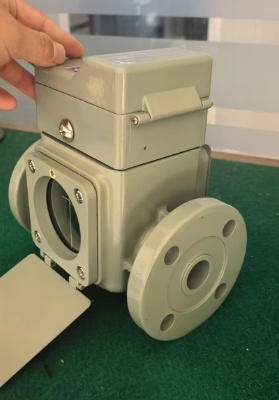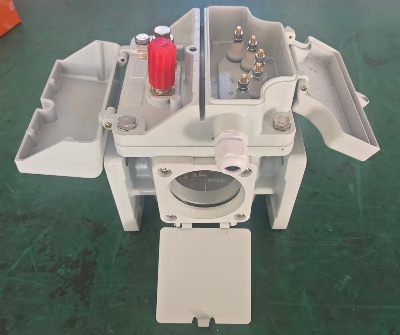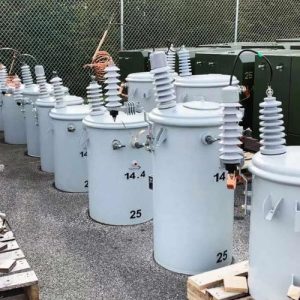Electronic Components Supplier | Transformers, Inductors, Inverters
The Buchholz Relay: A Guardian in the Grid – Principles, Types, and Critical Protection
Imagine a silent, unseen guardian living inside massive electrical transformers. This guardian works day and night, preventing catastrophic failures and ensuring our power supply remains stable. This guardian is the Buchholz relay. It is a simple yet brilliant device that has protected power transformers for over a century. Consequently, understanding its function is key for anyone in the electrical industry.
This article will explain everything you need to know about the Buchholz relay. We will explore its history, how it works, and the different relay type variations. Furthermore, we will discuss its critical role in modern power systems and why it remains a cornerstone of electrical safety.

Physical picture of QJ4-25 gas relay
1.1 Who was Max Buchholz?
The Buchholz relay is named after its inventor, Max Buchholz. He was a German engineer who introduced the device in 1921. During his time, transformers were becoming larger and more critical to power networks. However, they were also vulnerable to internal faults that could lead to explosions and fires. Max Buchholz‘s invention provided a direct solution to this growing problem. His device was a breakthrough because it could detect internal faults that external systems could not see. Therefore, the name Buchholz is forever linked to transformer safety.
1.2 The Fundamental Operating Principle
The Buchholz relay operates on a simple mechanical principle. It is installed in the pipe that connects the main transformer tank to its conservator (the oil-expansion tank). The relay is completely filled with insulating oil when the transformer is running normally. It contains two hinged floats, each with a mercury switch. These floats are strategically positioned to detect different types of faults.
Essentially, the Buchholz relay is a gas-detection relay type. When a minor internal fault occurs, slow-producing gases accumulate in the relay. This process causes the oil level to drop. As a result, the upper float tilts and closes its mercury switch. This action typically triggers an alarm, signaling operators that a problem is developing. For major faults, a rapid surge of oil flows towards the conservator. This surge displaces the lower float, causing it to tilt and close its circuit. This second switch usually trips the transformer offline, preventing extensive damage.
2. Deep Dive into Buchholz Relay Functionality and Alarms
Understanding the specific faults a Buchholz relay detects is crucial for interpreting its alarms and taking correct action.
2.1 What Faults Does it Detect?
The Buchholz relay is uniquely positioned to identify several dangerous conditions:
- Incipient Faults: These are slow-developing faults like localized overheating or partial discharge. They decompose the insulating oil, producing gases that bubble up into the relay.
- Major Internal Faults: These include severe problems like short-circuited windings or core faults. They generate a large amount of gas very quickly, creating the oil surge that activates the trip circuit.
- Loss of Oil: If a leak causes the oil level in the transformer to fall too low, the upper float will activate, sending an alarm before the transformer’s exposed parts overheat.
2.2 Interpreting the Alarms and Trips
Each relay type signal requires a specific response. The alarm circuit is an early warning. When it activates, operators should immediately take note. They should also take gas samples from the relay for analysis. This analysis, called Dissolved Gas Analysis (DGA), can pinpoint the exact nature of the fault inside the transformer. Conversely, a trip signal is an immediate emergency. It means the Buchholz relay has detected a severe fault that could destroy the transformer. The transformer is automatically disconnected from the power grid to isolate the failure.
3. Exploring Different Buchholz Relay Types and Modern Variations
While the classic mechanical Buchholz relay is the most common, several relay type designs have emerged to suit different applications.
3.1 The Standard Mechanical Buchholz Relay
This is the traditional relay type described throughout this article. It is purely mechanical, relying on floats, hinges, and mercury switches. Its main advantages are simplicity, reliability, and low cost. However, it can be sensitive to mechanical shocks and may require calibration over time.
3.2 Modern Electronic and Smart Relays
Technology has introduced new relay type options. Electronic Buchholz relay versions use sensors to detect gas accumulation and oil flow. They often include digital displays and communication capabilities. For example, a modern relay type can send real-time data to a control center. This allows for better monitoring and integration with smart grid systems. These “smart” relays provide more precise data but are generally more expensive than their mechanical counterparts.
3.3 Specialized Relay Types for Specific Applications
Some transformers, particularly smaller ones, may use a different relay type of protection. However, for large power transformers filled with oil, the Buchholz relay remains the standard. Other relay type devices, like sudden pressure relays, may be used in conjunction with the Buchholz relay for a multi-layered protection scheme.

Physical picture of QJ4-50 gas relay
4. The Undiminished Importance of Buchholz Relays Today
In an era of digital transformation, the Buchholz relay is as relevant as ever. It is a first-line defense that is completely independent of the electrical system. This independence is its greatest strength.
4.1 A Critical Component for Grid Stability
Power transformers are among the most expensive and critical assets in the electrical grid. A single transformer failure can cause widespread blackouts and cost millions in repairs and lost revenue. The Buchholz relay directly prevents these failures. By providing early warnings, it allows for planned maintenance, preventing unplanned outages. Therefore, it is not just a protective device but also a key tool for asset management and grid reliability.
4.2 Buchholz Relays and the Renewable Energy Sector
The growth of renewable energy creates new demand for the Buchholz relay. Large solar farms and wind power plants use massive step-up transformers to connect to the grid. These transformers are often located in remote areas. Protecting them is essential. The reliable, self-powered nature of the mechanical Buchholz relay makes it ideal for these applications. It provides robust protection without relying on external power sources.
4.3 Installation, Testing, and Maintenance
Proper installation is critical for a Buchholz relay to function correctly. It must be mounted correctly in the pipe between the transformer and the conservator. Regular maintenance is also essential. This includes checking for false operations, testing the mechanical components, and ensuring the electrical circuits are healthy. Neglecting maintenance can lead to a failure to operate when needed—or a false trip that disconnects a healthy transformer.
Conclusion
In summary, the Buchholz relay is a timeless masterpiece of electrical engineering. From its invention by Max Buchholz to its modern electronic versions, this specific relay type has proven indispensable. It offers unique, fundamental protection for oil-filled transformers by detecting internal faults that no other device can. Its simple principle of gas and oil flow detection makes it incredibly effective and reliable. As our power systems evolve and grow more complex, the role of this vital guardian becomes even more important. For ensuring safety, preventing disasters, and maintaining a stable electricity supply, the Buchholz relay truly is a silent hero in the world of electrical power.
Luoyang Datang Energy Technology Co., Ltd. is a high-tech enterprise integrating R&D, manufacturing and supply of power equipment such as transformers, new energy components, distribution cabinets and inverters. With technological innovation as the core, we focus on creating high-reliability and high-performance power solutions to serve global customers. With a strict quality control system and international standard certification, we continue to output excellent products and enable customers to build safe and stable power systems.






